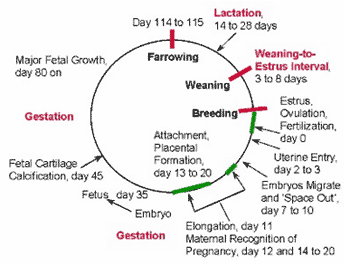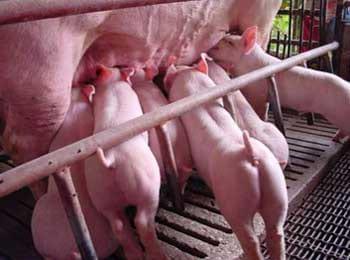Orego-Stim for the lactating sow and its litter
Orego-Stim® for the lactating sow and its litter
Large differences in sow productivity exist from one management system to another. These variations are considerably impacted by the distinctive feed and feeding programs in a sow’s reproductive lifetime. Proper feeding during gestation conditions the sow and enables her to manage feed intake during lactation resulting in a greater number of heavier piglets weaned. Adequate feed intake during lactation along with proper health care, will not only benefit the litter currently on the sow, but also improve the sow’s overall reproductive performance in subsequent litters, when considering farrowing rate and the number of piglets born alive.
Maintaining high levels of feed intake during lactation is not easy, since a sow has to increase its feed intake by a huge margin from the amount consumed during gestation to meet its own energy demands and to provide enough energy and nutrients for milk production. Problems arise, especially in young sows, if they do not consume enough feed during lactation to meet their energy requirements for maintenance, growth and milk production.
In order to achieve a higher sow productivity, it is important to understand the breeding and reproduction cycle as shown in Figure 1. Sow productivity depends heavily on the feed management of the breeding female population.
Figure 1: Critical Periods for Increasing Sow Productivity
The Importance of Lactation Feeding
A complete reproductive cycle is one of the most energetically expensive and challenging activities that a sow can undertake. First litter females are especially vulnerable to energy and nutrition deficit, which typically occurs during lactation. Adequate intake of feed during lactation is important for first litter females since excessive loss of body fat and protein results in a prolonged weaning-to-oestrus interval and reduced subsequent litter size. In practice, the extension of this interval almost always results in culling due to presumed reproductive failure.
For multiparous females, the nutrient needs for milk production are usually met by increased feed intake or by a larger body size from which nutrients can be derived from. However, sows sometimes suffer from a progressive decrease in body reserves due to an underestimation of the required amount of feed that is needed to rebuild them during the ensuing gestation. Severe and chronic depletion of body protein and fat reserves affects and compromises the reproductive performance of the sow. The impact on the lifetime performance of the sow can be significant and economically damaging if this goes uncorrected.
The correct feeding strategy during lactation should be to maximize feed consumption. Feeding methods are too often inadequate for prolific sows. It is normal for lactating females to lose weight but excessive weight loss may result in a prolonged weaning-to-oestrus interval and a decrease in litter size. These may occur with low lactation feed consumption, or with a low energy or low protein intake. The importance of lactation feed intake on subsequent reproductive performance increases with a higher number of pigs produced and with younger sows as compared to older sows.
The Effects of Inadequate Feeding During Lactation
If a sow fails to consume enough feed during lactation, milk production declines and conditioning is lost as fat reserves are mobilized to synthesize milk. This loss of fat and accompanying loss of protein mass both affect reproductive performance. The affected sow’s weaning-to-rebreeding interval will be extended, and farrowing rate and subsequent litter size are also challenged as the number of eggs ovulated decreases.
The effect of decreased feed intake on the sow’s litter is also important. There is a direct correlation between feed intake and piglet performance. As feed intake increases, milk production rises, increasing piglet growth rates. A sow that is producing enough milk also has decreased preweaning mortality rates.
The need for a consistent and high level of feed intake during lactation has been emphasized almost incessantly by veterinarians, nutritionists and reproductive physiologists. The mechanisms are complicated, but the outcome of inadequate feeding during lactation is constant, affecting one or more of a combination of reproduction parameters that include increased weaning-to-service intervals, poor farrowing rates, reduced litter sizes, and increased culling and mortality rates.
One of the most common mistakes in management is a failure to recognize that during lactation, females are also susceptible to heat stress when temperatures reach and exceeds 26°C for short or extended periods of time. High ambient temperatures can be devastating to feed intake but little can be done about it from a nutritional standpoint.
Have we been able to improve a great deal in this area with the amount of emphasis placed on it? In many cases it has been difficult to measure and more difficult to change in our production systems. In some cases we have compensated for low feed intake levels by using compounds such as antibiotics, chromium or beta carotene. In other cases we have simply compensated for poor reproductive performance by increasing the sow herd. In many cases we must re-examine our efforts and try once again to improve the level of feed intake during lactation.
Orego-Stim®: A Natural Solution
Orego-Stim® is a natural, phytogenic feed additive containing oregano essential oil, extracted from a specific chemotype of Origanum vulgaressp.hirtum. This exquisite hybrid species of oregano is derived from a selective plant-breeding programme developed by the Aristotle University of Thessaloniki and grown commercially under strictly-controlled plantation conditions in the mountainous slopes of Greece.
The availability of this pure oregano oil is exclusively used by Meriden Animal Health for the manufacture of Orego-Stim®. Orego-Stim® has undergone 20 years of ongoing research and development and continues to be the market leader amongst all other essential oils in the livestock industry.
The composition of the oil consists predominantly of a unique ratio and concentration of the natural phenolic compounds carvacrol and thymol, which are known to be powerful antimicrobial agents. Phenols kill organisms such as bacteria through its toxic effect on the cell wall, by denaturing and coagulating the proteins within the cell wall structure. The increase in permeability causes leakage of cellular constituents, resulting in water imbalance and cell death.
The Benefits of Orego-Stim® During the Lactation Period of Sows
Phenols are well-known aromatic substances that are commonly used as flavourings. The natural phenols contained within Orego-Stim® act as appetizers to enhance feed palatability. Its isoprenoids stimulate both the senses of smell and taste in pigs, by triggering the olfactory and glossopharyngeal pathways of the cranial nerves, stimulating more saliva production. As a result, the lactating sow consumes more feed, which lead to higher milk production.
A trial conducted in Korea has shown that Orego-Stim® was able to increase the villus-crypt depth ratio, due to the absence of pathogenic bacteria such as E. coli that are known to cause a premature shortening of the villi. Longer villi inevitably mean more surface area for better absorption of energy and other nutrients from the feed. At the same time, Orego-Stim® stimulates the production of digestive enzymes in the gut such as alkaline phosphatase, leucine aminopeptidase, sucrase, maltase and lactase, which are essential for the digestion process. This ensures optimal utilisation of feed for the lactating sow and her litter.
Meanwhile, it is a widely-recognised fact that more than 80% of newborn piglet infections are transmitted directly from their dam, especially via her faeces. Orego-Stim® minimizes the risk of disease transmission from the sow to her litter, especially during the first few days after farrowing, by reducing the amount of pathogens in her faeces.
Orego-Stim® also benefits the piglets directly. When used in creep feed, it acts as an appetizer to help the piglets to quickly get accustomed to consuming solid feed while at the same time helping their digestive systems to develop and mature faster. As a performance enhancer, Orego-Stim® produces heavier piglets at weaning. At the same time, it helps piglets to overcome post-weaning stress more quickly and easily, and with less complications.
Orego-Stim® also controls diarrhoea and gastrointestinal tract infections which frequently occur at this age, which may be caused by a variety of gastrointestinal pathogens such as E. coli, Clostridium perfringens, Isospora suis, Salmonella spp. and Campylobacter spp.. The absence of such pathogens from the gastrointestinal tract ensures optimal health of the digestive system of the piglets, resulting in improved feed conversion, better growth rates and reduced mortality.
Orego-Stim® Trial in Lactating Sows & Their Piglets
A study was designed to investigate the effect of Orego-Stim® on sows and their piglets’ performance and as a growth enhancing and alternative antibacterial in sows and their piglets’ feed. The trial was conducted by Professor Dr. Jowaman Khajarern from the Department of Animal Science of Khon Kaen University in Thailand in a well-managed commercial farm. Orego-Stim® was supplemented in the gestation feed at day 84 of the gestation period, which is about a month before farrowing, and continued throughout the entire lactation period until farrowing. Orego-Stim® was also subsequently added into the creep feed of the piglets.
The reproductive performance of sows and the growth performance and health of their litters were compared between 12 sows on Orego-Stim® and 12 in the control group. Orego-Stim®-fed sows produced a significantly higher number of piglets born alive, average birth weight and total number of piglets at weaning when compared with the control group.
Results from this study proved that Orego-Stim® stimulated a higher feed intake in lactating sows which showed appetite enhancement with better utilization of feed. This is shown by a significant increase in milk yield and milk quality which can be significantly measured by a more rapid pre-weaning weight gain, greater total weight of piglets weaned per litter and a higher average bodyweight of piglets attained at weaning.
The inclusion of Orego-Stim® in the creep feed also mimicked the responses as in the lactating feed, as an alternative to antibiotic growth promoters, flavour and appetite enhancers and also assisted in digestion for better nutrient absorption. Piglets fed with Orego-Stim® showed significantly higher feed intake and daily weight gain, better uniformity of bodyweight at weaning and also a higher but non-significant survivability rate of piglets at weaning when compared to the negative control piglets group. See Figure 2 for complete results of the trial.
Figure 2: Efficacy of Orego-Stim® on the Performance of Sows and their Piglets
Parameter | Negative Control | Orego-Stim® |
Number of sows | 12 | 12 |
Total number of piglets born | 125 | 126 |
Average number of piglets born per litter | 10.42 | 10.50 |
Total number of piglets born alive | 119 | 121 |
Average number of piglets born alive per litter | 9.92 | 10.08 |
Total birth weight per litter (kg) | 15.18b | 16.28a |
Average birth weight of piglets (kg) | 1.55 | 1.67 |
Total number of piglets at weaning | 114 | 117 |
Average number of piglets weaned per litter | 9.50 | 9.75 |
Survival rate of piglets at weaning (%) | 96.12 | 97.03 |
Total weight of piglets weaned per litter (kg) | 64.62b | 70.59a |
Average body weight of piglets at weaning (kg) | 6.84b | 7.26a |
Uniformity of body weight of piglets at weaning | 87.73b | 89.65a |
Total feed intake of piglets per litter (kg) | 1.54b | 1.74a |
Average feed intake per piglets (g) | 161b | 178a |
Average daily gain of piglets (g) | 252b | 268a |
Average feed intake of sow during lactation (kg/d) | 5.86b | 6.33a |
Average milk yield (litres/day) | 9.53b | 10.44a |
a, b Means in the same row bearing different superscripts differ (P<0.05)

Figure 3: Difference Between the Control Sow and the Orego-Stim® Sow by Observation
Figure 4: Piglets from the Orego-Stim® Sow – Heavier, Healthier & Higher Uniformity





.jpg&w=3840&q=75)